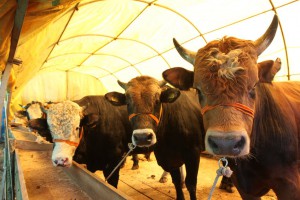The Sacrifices We Make: Seeing Through Ritual Killings
 A livestock tent set up prior to Eid al-Adha celebrations in Istanbul, Turkey.
A livestock tent set up prior to Eid al-Adha celebrations in Istanbul, Turkey. This year’s worldwide celebration of Muslim holiday Eid al-Adha recently concluded on September 15. For those unfamiliar with Eid al-Adha, the holiday is meant to commemorate Ibrahim’s willingness to kill his son in the name of God, though fortunately the angel Jibra’il appears in the nick of time to tell Ibrahim that he does not need to go through with the sacrifice. Although this holiday is a commemoration of a rather disturbing story of control, commitment, and obedience in the name of religion, it is celebrated across the globe by Muslims seeking appeasement. Also called the “Festival of the Sacrifice,” Eid al-Adha is observed each year by killing thousands of cows and sheep. This year, Bangladesh made headlines by killing so many that its streets turned red with blood.
The practice, though traditional, has become controversial. In October 2014, Egyptian writer Fatima Naoot was charged with contempt of religion and sentenced to three years of imprisonment for criticizing the holiday. She described the holiday on Facebook as a “massacre” based on a “startling nightmare one of the righteous ones had about his son.”
Islam is not the only religion to ask for animal sacrifice. Just last week in Florida, a woman discovered decapitated goats, chickens, and ducks scattered amongst cut flowers. Authorities believe that the disturbing act of violence is linked to a religious ritual killing involving Santeria. Lisa Heyworth, a witness, claims that this is not the first ritual killing she has experienced. She said, “I have personally witnessed probably at least twenty separate incidents where the animals are left in a ritual-type fashion.”
Clearly, the concept of killing other animals in the name of a god is highly problematic, especially when we acknowledge animals’ disposable status in many religions as well as in our current economic and social systems. In the United States, religious killing is not outlawed. Although a local town in Florida tried to ban ritual slaughter in 1993, the Supreme Court declared the ban unconstitutional. The ruling makes sense when considering current American dietary norms, as the reverse could open a challenge to other forms of ritual animal killings in the United States, like those within the meat and dairy industries.
The United States’ law and its relationship to nonhuman animals is quite complex and oftentimes contradictory. Although some substandard welfare protections exist for lab animals, the pain we subject mice, birds, and rats to in the lab is so severe and frequent that they are not even considered animals under the Animal Welfare Act. While abusing a dog and cat may land you in jail and listed on a registry, the exploitation of animals such as pigs, cows, sheep, goats, turkeys, and chickens under our agricultural system is largely unregulated. It’s concerning that rather than seeking viable alternatives, we manipulate law and scientific fact in order to make our violence more easily digestible.
“You just should not have to encounter this type of situation. It’s disturbing,” Heyworth told reporters in response to the Santeria sacrifice. If we are appalled by the very images these ritual slaughters provoke, why are we not appalled by the images that appear behind the closed doors of CAFOs (concentrated animal feeding operations) and slaughterhouses? In truth, it would be unreasonable to believe that there is a significant difference between killing in the name of religion and killing for flavor.
Animal sacrifices are needless acts of violence. By using the phrase “needless acts of violence,” however, I am not implying that there are severe acts of violence that aren’t needless. Rather, I want to highlight just how unwarranted, wasteful, and horrific systems of religion, scientific testing, and agriculture are in the violence they inflict upon nonhuman animals and impose on humans. As humanists, don’t we have a responsibility to reject all traditions of violence?
